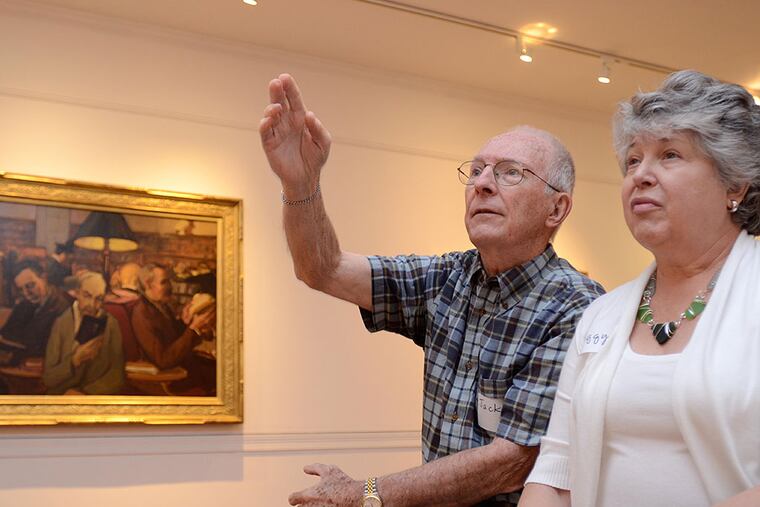Living with Alzheimer's with the help of art
Through a work of art, the two women were hoping to save a connection that is slipping away. Their husbands, who have Alzheimer's disease, are becoming more distant, their marriages more solitary and fraught with worry.

Through a work of art, the two women were hoping to save a connection that is slipping away.
Their husbands, who have Alzheimer's disease, are becoming more distant, their marriages more solitary and fraught with worry.
But in a discussion of a painting called The Immigrants, those husbands - Jack Williams and Dick Force - virtually carried the conversation at the Woodmere Art Museum, in Chestnut Hill.
The two men, whose wives had met through their mutual experience as caregivers, found the story in the brushstrokes and shared their thoughts about the discovery.
That a 1923 painting by Theresa Bernstein had stimulated such a connection is exactly the response that Susan Shifrin was aiming for. The former associate education director at the Berman Museum of Art at Ursinus College, in Montgomery County, has started an organization whose goal is to serve, through arts and culture, people with Alzheimer's and other forms of dementia.
The year-old ARTZ Philadelphia is a branch of ARTZ: Artists for Alzheimer's, a national organization based in Boston that creates arts programming for people with the diagnosis and incorporates the participation of caregivers.
ARTZ Philadelphia is offering tours, arts activities, training, and research.
Two years ago, Shifrin, of Plowville, Berks County, helped create an exhibition at Ursinus for people with dementia. During visits, Shifrin, whose mother has the condition, observed a pattern.
"They would arrive somewhat disoriented and anxious, but within 10 minutes of sitting in front of a painting, they were themselves," Shifrin said. "They were laughing, making observations. They were having real conversations."
When Shifrin left Ursinus, she decided to start an area branch of ARTZ.
The group began offering monthly tours at the Woodmere earlier this year. Other tours are being planned at the Barnes Foundation and the La Salle University Art Museum.
The program will work with the University of Pennsylvania Museum of Archaeology and Anthropology to expand the museum's Touch Tours, which offer the vision-impaired the chance to touch works of art.
Studies on art therapy and its effects on patients with dementia indicate that patients experience a sense of well-being and seem more engaged when they are participating. But the investigations do not meet rigorous scientific standards, said Anjan Chatterjee, chief of neurology at Pennsylvania Hospital.
For instance, scientists do not know if those effects are specific to art therapy, Chatterjee said.
To help find out, Chatterjee is working on research with ARTZ Philadelphia and the Penn Memory Center that aims to study the effects of art therapy on people in the early stages of Alzheimer's.
The Penn Memory Center studies and treats patients 65 and older who are experiencing progressive memory loss and changes in thinking, communication, and personality.
Florence Gelo, an associate professor at the Drexel University College of Medicine, says that she has witnessed in museums the transformative power of the arts.
"It shows that [people with Alzheimer's] can access memory. They can interact," Gelo said. "It shows the person with dementia fully as a human being," she said.
The medical school is collaborating with ARTZ Philadelphia to help doctors studying family medicine understand patients with dementia. The residents visit Woodmere to observe Shifrin leading a tour.
Inside the museum, officials are responsible for ensuring that families and residents from care facilities feel at ease, said Hildy Tow, Woodmere's curator of education. Caregivers should not have to worry that their loved ones and patients might walk away, say something inappropriate, or disturb the quiet atmosphere of a museum, Tow said.
The art can inspire people with dementia and their caregivers, Tow said. The caregivers see a loved one reacting in an animated, responsive way that might have been rare since the onset of the disease.
That happened recently when Peggy Williams, of Exton, and Beth Ann Force, of Bethlehem, toured the Woodmere.
The two watched and joined in the discussion among a group of eight as their husbands talked about Bernstein's work.
Dick Force, 70, a retired school administrator, called the depiction of an immigrant mother and child on a boat coming to America evocative of the Virgin Mary.
Jack Williams, 73, a retired sales and marketing manager, observed that one group of figures on the boat may have been looking toward the future, while the other remembered the past.
"My husband opened up in ways that surprised me, and I think it surprised him as well," Peggy Williams said. "I really think it just makes him feel better about himself."
Beth Ann Force said it was good for her husband to be able to talk in a relaxed way with someone else.
After the exhibit, the two couples ate lunch at a restaurant in Chestnut Hill, and Peggy Williams said, "It was nice."
610-313-8211